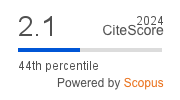A Deep Learning Approach for Ship Detection Using Satellite Imagery
DOI:
https://doi.org/10.4108/eetiot.5435Keywords:
Satellite imagery, Maritime Security, Copernicus Open Hub, Run Length EncodingAbstract
INTRODUCTION: This paper addresses ship detection in satellite imagery through a deep learning approach, vital for maritime applications. Traditional methods face challenges with large datasets, motivating the adoption of deep learning techniques.
OBJECTIVES: The primary objective is to present an algorithmic methodology for U-Net model training, focusing on achieving accuracy, efficiency, and robust ship detection. Overcoming manual limitations and enhancing real-time monitoring capabilities are key objectives.
METHOD: The methodology involves dataset collection from Copernicus Open Hub, employing run-length encoding for efficient preprocessing, and utilizing a U-Net model trained on Sentinel-2 images. Data manipulation includes run-length encoding, masking, and balanced dataset preprocessing.
RESULT: Results demonstrate the proposed deep learning model's effectiveness in handling diverse datasets, ensuring accuracy through U-Net architecture, and addressing imbalances. The algorithmic process showcases proficiency in ship detection.
CONCLUSION: In conclusion, this paper contributes a comprehensive methodology for ship detection, significantly advancing accuracy, efficiency, and robustness in maritime applications. The U-Net-based model successfully automates ship detection, promising real-time monitoring enhancements and improved maritime security.
Downloads
References
Vachon, P.W.; Campbell, J.W.M.; Bjerkelund, C.A.; Dobson, F.W.; Rey, M.T. Ship detection by the RADARSAT SAR: Validation of detection model predictions. Can. J. Remote Sens. 23, 48–59, 1997.
Chong, J.; Zhu, M. Survey of the Study on Ship and Wake Detection in SAR Imagery. Acta Electron. Sin., 31, 1356–1360. 2003.
Wang Juan, Sun Lijie, and Zhang Xuelan Study Evolution of Ship Target Detection and Recognition in SAR Imagery Institute of Technology, Beijing, China 2009.
Gao, G. A Parzen-Window-Kernel-Based CFAR algorithm for ship detection in SAR Images. IEEE Geosci. Remote Sens. Lett., 8, 557–561,2011.
Liu, C. A Dual-Polarization Ship Detection Algorithm; Defence Research Development Canada, Ottawa Research Centre: Ottawa, ON, Canada, 2015.
Xi, Y.; Zhang, X.; Lai, Q.; Li, W.; Lang, H. A New PolSAR Ship Detection Metric Fused by Polarimetric Similarity and the Third Eigenvalue of the Coherency Matrix. In Proceedings of the IEEE International Geoscience and Remote Sensing Symposium, Beijing, China, 10–15 July; pp. 112– 115 ,2016.
Yu, W.; Wang, Y.; Liu, H.; He, J. Superpixel-Based CFAR Target Detection for High-Resolution SAR Images. IEEE Geosci. Remote Sens. Lett. 13, 730–734,2016.
Fan, Q.; Chen, F.; Cheng, M.; Wang, C.; Li, J. A Modified Framework for Ship Detection from Compact Polarization SAR Image. In Proceedings of the IEEE International Geoscience and Remote Sensing Symposium, Valencia, Spain, pp. 3539–3542, 22–27 July 2018.
Markopoulos, P.; Dhanaraj, M.; Savakis, A. Adaptive L1-Norm Principal-Component Analysis with Online Outlier Rejection. IEEE J. Sel. Top. Signal Process, 12, 1131–1143, 2018.
Javed, S.; Mahmood, A.; Al-Maadeed, S.; Bouwmans, T.; Ki Jung, S. Moving Object Detection in Complex Scene Using Spatiotemporal Structured-Sparse RPCA. IEEE Trans. Image Process.28, 1007–1022,2018.
Biondi, F. Low-Rank Plus Sparse Decomposition and Localized Radon Transform for Ship-Wake Detection in Synthetic Aperture Radar Images. IEEE Geosci. Remote Sens. Lett, 15, 117–121, 2018.
Li, C.; Yu, Z.; Chen, J. Overview of Techniques for Improving High-resolution Spaceborne SAR Imaging and Image Quality. J. Radars 8, 717–731,2019.
Liu, T.; Yang, Z.; Yang, J.; Gao, G. CFAR Ship Detection Methods Using Compact Polarimetric SAR in a K-Wishart Distribution. IEEE J. Sel. Top. Appl. Earth Obs. Remote Sens. 12, 3737– 3745,2019.
Z. Chu, T. Tian, R. Feng, and L. Wang, "Sea-Land Segmentation With Res-UNet And Fully Connected CRF," IGARSS 2019 - 2019 IEEE International Geoscience and Remote Sensing Symposium, Yokohama, Japan, 2019, pp. 3840-3843, doi: 10.1109/IGARSS.2019.8900625.
A. Khatri, T. Choudhury, T. P. Singh, and M. Shamoon, "Video Analytics Based Identification and Tracking in Smart Spaces," 2019 International Conference on Contemporary Computing and Informatics (IC3I), Singapore, 2019, pp. 261-267, doi: 10.1109/IC3I46837.2019.9055614.
Li, J.; Tian, J.; Gao, P.; Li, L. Ship Detection and Fine-Grained Recognition in Large-Format Remote Sensing Images Based on Convolutional Neural Network. In Proceedings of the IEEE International Symposium on Geoscience and Remote Sensing (IGARSS), Waikoloa, HI, USA, pp. 2859–2862, 26 September–2 October 2020.
Ai, J.; Cao, Z.; Xing, M. An Adaptive-trimming-depth Based CFAR Detector of Heterogeneous Environment in SAR Imagery. Remote Sens. Lett., 11, 730–738,2020.
Marfu'ah, N. J. L., & Kurniawardhani, A. Comparison of CNN and SVM for ship detection in satellite imagery. In 2020 3rd International Conference on Information and Communication Technology (ICICT) (pp. 1-5). Atlantis Press, 2020
Ciocarlan, A.; Stoian, A. Ship Detection in Sentinel 2 Multispectral Images with Self-Supervised Learning. RemoteSens. 13,4255, 2021
Ai, J.; Cao, Z.; Mao, Y.; Wang, H.; Wang, F.; Jin, J. An Improved Bilateral CFAR Ship Detection Algorithm for SAR Image in Complex Environment. J. Radars 10, 499–515, 2021
Liu, T.; Yang, Z.; Jiang, Y.; Gao, G. Review of Ship Detection in Polarimetric Synthetic Aperture Imagery. J. Radars 10, 1–19, 2021.
S. Karki and S. Kulkarni, "Ship Detection and Segmentation using Unet," 2021 International Conference on Advances in Electrical, Computing, Communication and Sustainable Technologies (ICAECT), Bhilai, India, 2021, pp. 1-7, doi: 10.1109/ICAECT49130.2021.9392463.
Downloads
Published
Issue
Section
License
Copyright (c) 2024 EAI Endorsed Transactions on Internet of Things

This work is licensed under a Creative Commons Attribution 3.0 Unported License.
This is an open-access article distributed under the terms of the Creative Commons Attribution CC BY 4.0 license, which permits unlimited use, distribution, and reproduction in any medium so long as the original work is properly cited.




